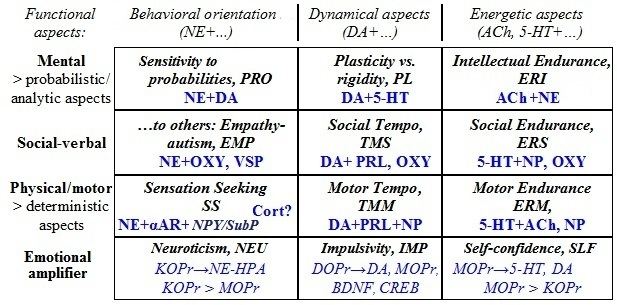 | ||
Functional Ensemble of Temperament (FET) is a neurochemical model suggesting specific functional roles of main neurotransmitter systems in regulation of behavior.
Contents
Earlier theories
We use medications to adjust a release of brain neurotransmitters in cases of depression, anxiety disorder, schizophrenia and other mental disorders because an imbalance within neurotransmitter systems can emerge as consistent characteristics in behaviour compromising people’s lives. All people have a weaker form of such imbalance in at least one of such neurotransmitter systems that makes each of us distinct from one another. The impact of this weak imbalance in neurochemistry can be seen in the consistent features of behaviour in healthy people (temperament). In this sense temperament (as neuro-chemically-based individual differences) and mental illness represent varying degrees along the same continuum of neurotransmitter imbalance in neurophysiological systems of behavioral regulation
In fact, multiple temperament traits (such as Impulsivity, sensation seeking, neuroticism, endurance, plasticity, sociability or extraversion) have been linked to brain neurotransmitters and hormone systems.
By the end of the 20th century it became clear that the human brain operates with more than a dozen of neurotransmitters and a large number of neuropeptides and hormones. The relationships between these different chemical systems are complex as some of them suppress and some of them induce each other’s release during neuronal exchanges. This complexity of relationships devalues the old approach of assigning “inhibitory vs. excitatory” roles to neurotransmitters: the same neurotransmitters can be either inhibitory or excitatory depending on what system they interact with. It became clear that an impressive diversity of neurotransmitters and their receptors is necessary to meet a wide range of behavioural situations, but the links between temperament traits and specific neurotransmitters are still a matter of research. Several attempts were made to assign specific (single) neurotransmitters to specific (single) traits. For example, dopamine was proposed to be a neurotransmitter of the trait of Extraversion, noradrenalin was linked to anxiety, and serotonin was thought to be a neurotransmitter of an inhibition system. These assignments of neurotransmitter functions appeared to be an oversimplification when confronted by the evidence of much more diverse functionality. Research groups led by Petra Netter in Germany and Trevor Robbins in Cambridge, UK had most extensive studies of the links between temperament traits or dynamical properties of behavior and groups of neurotransmitters
Development of the FET model
The architecture of the Functional Ensemble of Temperament (FET) was developed by Trofimova as the Compact version of the Structure of Temperament Questionnaire (STQ-77) in 1997-2007. This model inherits the activity-specific approach to the structure of temperament proposed by Rusalov in mid-1980s. According to this approach, the traits of temperament (and behavioural regulation) related to motor-physical, social-verbal and mental aspects of activities are based on different neurophysiological systems and should be assessed separately (so you can see a separation of traits into 3 rows related to these 3 types of activities). The final STQ-77/FET model considers 12 systems (and temperament traits): 9 systems (and traits) regulating the formal functional aspects of behaviour (energetic, dynamic and orientational, each assessed in three domains (intellectual, physical and social-verbal) together with 3 systems related to emotionality (Neuroticism, Impulsivity and Self-Confidence) (see Figure).
The differences between Trofimova’s and Rusalov’s models of temperament (and the structures of their versions of the STQ) are:
In 2007-2013 this STQ-77 model of temperament was reviewed and compared to the main findings in neurophysiology, neurochemistry, clinical psychology and kinesiology resulting in the neurochemical FET model offered by Irina Trofimova, McMaster University. Trevor Robbins, Cambridge University who collaborated with Trofimova on this project in 2014-2016 suggested a revision of the part of the FET neurochemical hypothesis related to the trait of Intellectual Endurance (sustained attention). This neurochemical component of the FET hypothesis was upgraded in 2015 by underlying a key role of acetylcholine and noradrenalin in sustained attention.
Overview of the model
The final STQ-77/FET model considers 12 systems (and temperament traits): nine systems (and traits) regulating the formal functional aspects of behaviour (energetic, dynamic and orientational) each assessed in three domains (intellectual, physical and social-verbal) together with three systems related to emotionality (Neuroticism, Impulsivity and Self-Confidence) (see Figure). TheFET hypothesis suggests that the nine non-emotionality traits are regulated by the monoamines (MA) (noradrenalin, dopamine, serotonin), acetylcholine and neuropeptide systems, whereas the three emotionality-related traits emerge as a dysregulation of opioid receptors systems that have direct control over MA systems. Importantly, the FET model suggests that there is no one-to-one correspondence between the neurotransmitter systems underlying temperament traits (or mental disorders) but instead specific ensemble relationships between these systems emerge as temperament traits. The FET hypothesis is based only on the strongest consensus points in the research studying the role of neurotransmitter in behavioral regulation and the components of temperament; it doesn’t list more controversial links between these multiple systems.
† Neurotransmitter systems: 5-HT: serotonin; DA: dopamine; NE: noradrenalin; ACh: acetylcholine; Glu: glutamate; GH: Growth Hormone; SOM: Somatostatin; PRL: prolactin; OXY: oxytocin; SubP: Substance P; NPY: Neuropeptide Y; KOPr, MOPr, DOPr: kappa-, mu- and delta-opioid receptors correspondingly; AdrR - adrenergic receptors.
